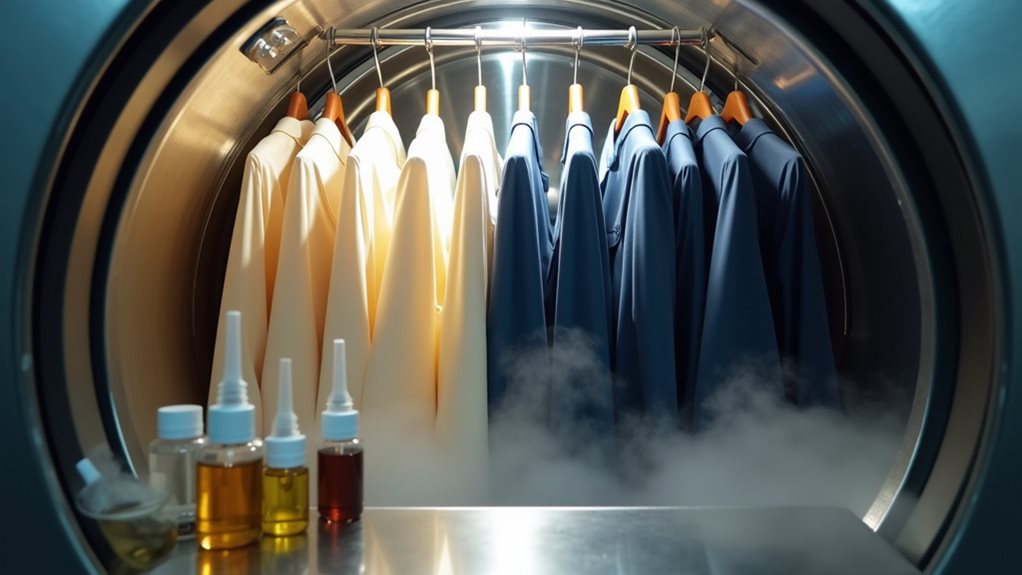You can definitely handle basic dry cleaning at home with the right approach, though I’ve learned the hard way that some pieces need professional care 😅. Simple items like silk blouses, wool sweaters, and unstructured jackets respond well to gentle hand-washing with mild detergents, followed by careful air drying on flat surfaces. However, heavily beaded garments, structured suits, and anything labeled “dry clean only” should stay with the pros to avoid expensive mishaps. There’s so much more to master about this money-saving skill.
Understanding When Dry Cleaning Is Necessary
When I first started living on my own, I’ll admit I was that person who threw everything into the washing machine without a second thought, including my roommate’s expensive silk blouse (sorry, Sarah! 😅).
That disaster taught me the importance of understanding fabric composition and recognizing when professional dry cleaning is absolutely necessary.
Delicate fabrics like silk, wool, and cashmere require specialized cleaning methods because water-based cleaning can cause shrinking, color bleeding, and structural damage.
Items labeled “dry clean only” aren’t just suggestions – they’re requirements for maintaining garment integrity.
Structured suits, heavily beaded dresses, and garments with oil-based stains need professional care that home dry cleaning kits simply can’t provide, guaranteeing your investment pieces stay beautiful for years.
Additionally, dry cleaning becomes the only effective solution for removing stubborn stains like grease and makeup that traditional water-based washing methods cannot eliminate.
What You Need for Home Dry Cleaning
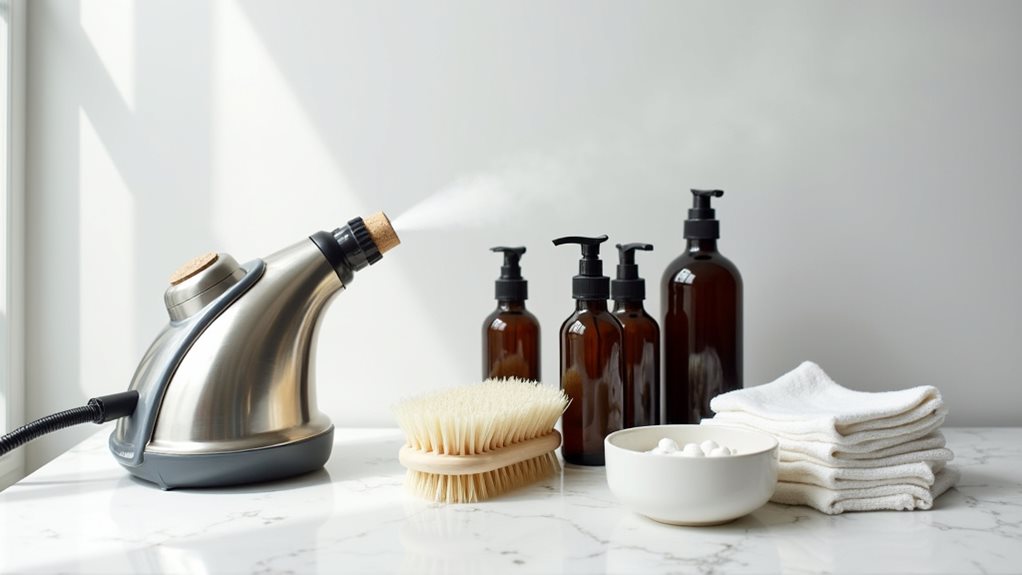
Before you transform your laundry room into a mini dry cleaning operation, you’ll need to gather the right equipment and tools, select appropriate cleaning products that won’t turn your favorite silk blouse into an expensive cleaning rag, and set up proper storage solutions to keep everything organized.
I learned this the hard way when I enthusiastically dove into home dry cleaning with nothing but regular detergent and a prayer, which resulted in a cashmere sweater that could now fit my neighbor’s chihuahua 😅.
The good news is that once you’ve assembled the crucial supplies, from specialized detergents to garment bags and steamers, you’ll have everything needed to tackle most dry-clean-only items safely and effectively. Home dry cleaning kits contain pre-moistened stain removal pens and cleaning cloths that activate in your dryer to release cleaning vapors that refresh your garments without water.
Essential Equipment and Tools
Success in home dry cleaning starts with assembling the right toolkit, and honestly, you probably already own most of what you’ll need hiding in your laundry room or linen closet.
Your automatic clothes dryer becomes the star player when paired with at-home dry cleaning kits, creating that professional cleaning magic without the hefty price tag.
A clothes steamer works wonders for wrinkle removal and revitalizing delicate fabrics between wears – think of it as your garment’s best friend.
Don’t forget your trusty steam iron and ironing board for those final touches, plus a pressing cloth to protect sensitive materials from scorch marks.
Round out your arsenal with sturdy clothes hangers and a flat drying rack to maintain proper garment shape during the entire process.
Modern home dry cleaning kits also include specialized solutions that work effectively with your existing washing machine for treating delicate items like silk and wool.
Cleaning Products and Solvents
Now that you’ve got your equipment sorted, let’s talk about the actual cleaning products that’ll transform your laundry room into a dry cleaning sanctuary – and I promise you won’t need to invest in anything remotely resembling the industrial solvents professional cleaners use.
At-home dry cleaning kits are your best friend here, complete with reusable dryer bags and specialized stain remover pens that actually work on delicate fabrics.
For those “dry clean only” pieces, mild detergents paired with gentle hand-washing can be surprisingly effective.
Don’t overlook your pantry staples: distilled white vinegar works magic as a natural solvent for freshening garments, while baking soda absorbs stubborn odors before you steam them away.
Keep in mind that while these home solutions work well for lightly soiled items and refreshing clothes, they may struggle with heavily stained garments or oil-based stains that require professional treatment.
Remember that pressing cloth when using your steamer!
Proper Storage Solutions
Once you’ve mastered the cleaning process, you’ll quickly realize that proper storage makes the difference between maintaining your freshly cleaned garments and watching them wrinkle back into submission overnight – trust me, I learned this the hard way after spending two hours steaming a silk blouse only to find it crumpled in my laundry basket the next morning.
Here’s what proper storage solutions actually look like:
- Create a well-ventilated area where you can hang garments immediately, preventing moisture buildup that leads to mildew.
- Invest in breathable garment bags made of cotton or muslin to protect delicate fabrics from dust.
- Keep a soft-bristle brush nearby for quick lint removal.
- Store your steamer and mild detergent as critical tools in accessible spots.
- Keep home dry cleaning kits in cool, dry places.
Remember that certain garments like wool suits, silk dresses, and items with intricate beading will always benefit most from professional dry cleaning services when your home methods aren’t sufficient.
Step-by-Step Home Dry Cleaning Process
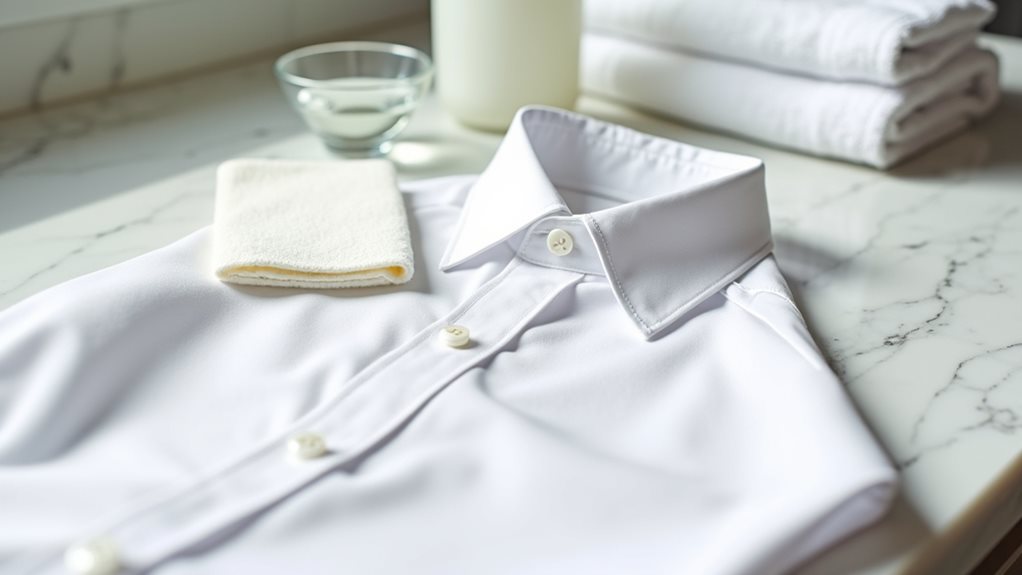
Now that you’ve gathered your supplies, it’s time to walk through the actual cleaning process, which honestly feels a bit like performing surgery on your favorite silk blouse the first time around.
You’ll start by preparing your garments carefully, checking those tiny care labels that seem designed to test your eyesight, then move into applying the right cleaning solutions with the gentle touch of someone handling a sleeping baby.
Before diving in, always test your chosen cleaning method on a hidden area like an inside seam or hem, since spot cleaning with gentle solvents can react differently depending on the fabric composition and dye.
The final stage involves proper drying and finishing techniques that’ll help your clothes look professionally cleaned, even though you’re doing it in your bathroom while wearing your comfiest pajamas 😊.
Preparing Garments First
Before you dive headfirst into transforming your living room into a makeshift dry cleaning operation, you’ll want to give your garments the thorough once-over they deserve, much like a detective examining evidence at a crime scene.
Preparing garments properly saves you from the heartbreak of ruined favorites (trust me, I’ve learned this lesson the expensive way 😅).
Here’s your crucial preparation checklist:
- Inspect for visible stains, holes, or loose threads that need attention first
- Check the care label thoroughly for “dry clean only” instructions
- Treat any stains before beginning the cleaning process
- Gather your supplies: delicate detergent, clean basin, and towels
- Clear space for a drying rack where you’ll hang delicate items afterward
Proper garment assessment helps you determine which items can safely be cleaned at home versus those requiring professional treatment.
Using Cleaning Solutions
After you’ve completed your detective work on those garments, it’s time to transform into a gentle chemist, mixing solutions that’ll breathe new life into your clothes without the harsh chemicals that make professional dry cleaning smell like a science experiment gone wrong.
Start by performing a spot test with delicate detergent on an inconspicuous area—trust me, I learned this lesson the hard way when my favorite blouse developed mysterious white patches 😅.
Fill your basin with cool water, add that teaspoon of gentle cleaning solutions, and let your garment soak peacefully. For stubborn spots, apply specialized stain removers before the bath.
After a thorough rinse, sprinkle baking soda for odor absorption, then air dry in a well-ventilated area. Remember that this home method works best as a maintenance tool between professional cleanings rather than a complete replacement for traditional dry cleaning services. Now you can dry clean at home like a pro!
Drying and Finishing
The magic really happens during the drying phase, where your patience and technique determine whether you’ll end up with a crisp, professional-looking garment or something that resembles a crumpled napkin from last week’s takeout 🙈.
After you soak and rinse your delicate items during dry cleaning at home, proper drying becomes essential to remove stains effectively and maintain fabric integrity:
- Lay garments flat on clean towels, gently reshaping them to their original form.
- Hang delicate items like silk on plastic hangers to prevent unsightly wrinkles.
- Use your automatic clothes dryer sparingly on a low heat setting for final touches.
- Ensure proper air circulation around drying garments for even moisture removal.
- Remove clothes promptly to avoid heat damage and maintain that fresh appearance.
This methodical approach helps you dry clean your clothes successfully at home. If damage does occur during your home dry cleaning attempts, understanding your consumer rights can help you seek compensation when taking items to professional services for repair or replacement.
Treating Stains Before Dry Cleaning
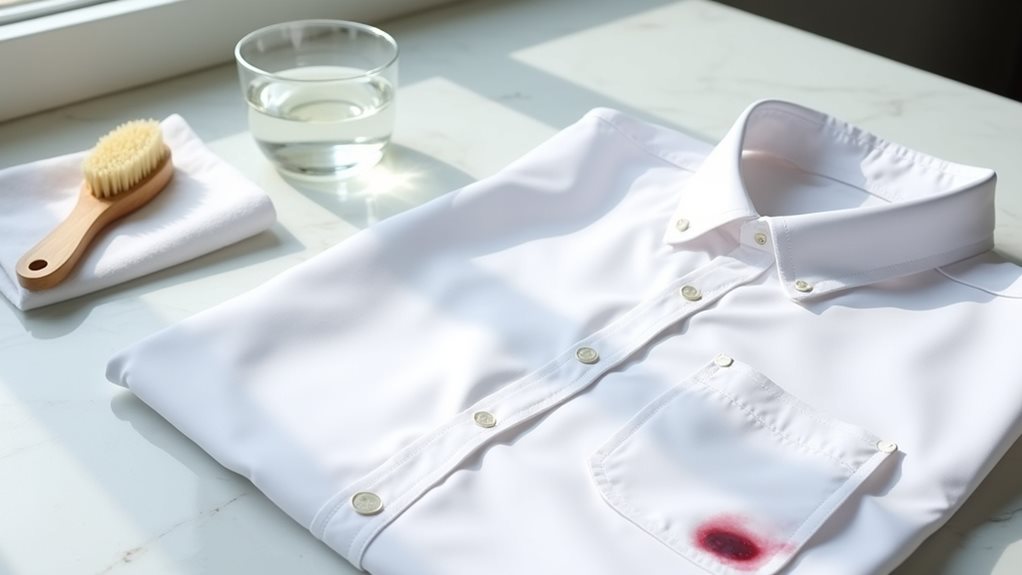
When you’re preparing to tackle dry cleaning at home, identifying and treating stains becomes your first line of defense against permanent fabric damage, and I learned this lesson the hard way after ruining my favorite silk blouse by skipping this crucial step.
Now I always examine my garment under good lighting, hunting for spots that could become disasters 😅.
For treating stains effectively, I grab a specialized stain remover that matches the culprit—whether it’s makeup, food, or those sneaky oil-based stains.
My secret weapon? A mixture of white vinegar and water works wonders on greasy mishaps.
Always do a spot test first to protect delicate fibers, then let everything air dry completely before proceeding—this prevents setting and guarantees your clean clothes at home efforts actually succeed.
Keep in mind that water-based stains like sweat and blood are particularly challenging for at-home dry cleaning methods and may require professional treatment for complete removal.
Garments Safe for Home Dry Cleaning
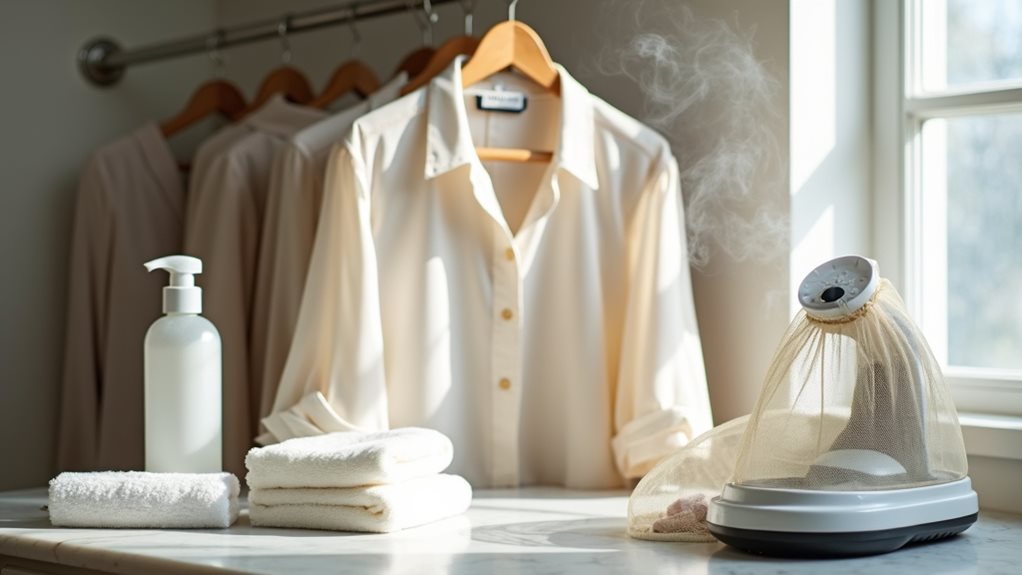
Understanding which clothes you can safely clean at home transformed my relationship with expensive dry cleaning bills, especially after I discovered that my collection of silk blouses, wool sweaters, and even my husband’s unstructured blazers could get the same professional treatment in my own laundry room.
When you understand fabric composition and follow proper care guidelines, at-home cleaning becomes a suitable option for many garments previously destined for professional services.
These delicate items work beautifully with home dry cleaning methods:
- Unstructured jackets and blazers made from wool or cashmere
- Silk blouses and lightweight trousers requiring gentle handling
- Sweaters in natural fibers that respond well to careful treatment
- Jeans and casual wear that benefit from specialized cleaning
- Rayon pieces when you follow specific cleaning instructions methodically
Even “dry clean only” labels don’t automatically disqualify home treatment.
Items That Require Professional Dry Cleaning
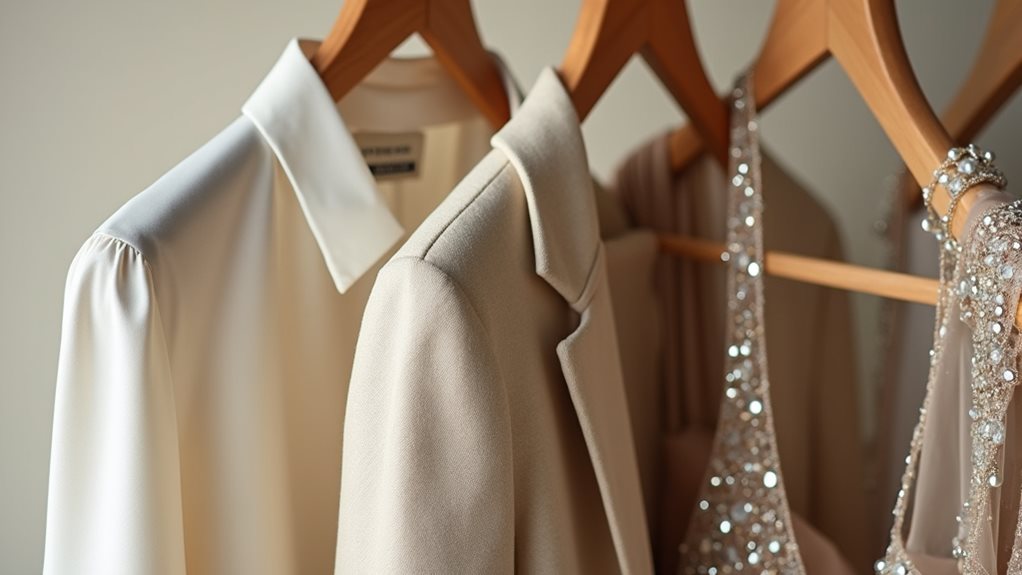
Several expensive mistakes taught me which garments absolutely need professional attention. I learned this lesson the hard way when I attempted to clean my grandmother’s vintage beaded evening gown at home, only to watch helplessly as delicate sequins loosened and the fabric’s integrity compromised beyond repair.
Now I know that dry-clean-only garments like fur coats, wedding dresses, and antique clothing deserve a professional dry cleaner’s expertise. The delicate nature of heavily beaded garments, structured garments with customized shoulders, and valuable items means they’ll suffer irreversible damage from home methods.
Fabrics prone to shrinking, like silk and wool, require professional handling to maintain their original fit and appearance – trust me on this one! 💔
Alternative Methods to Refresh Dry-Clean-Only Clothes
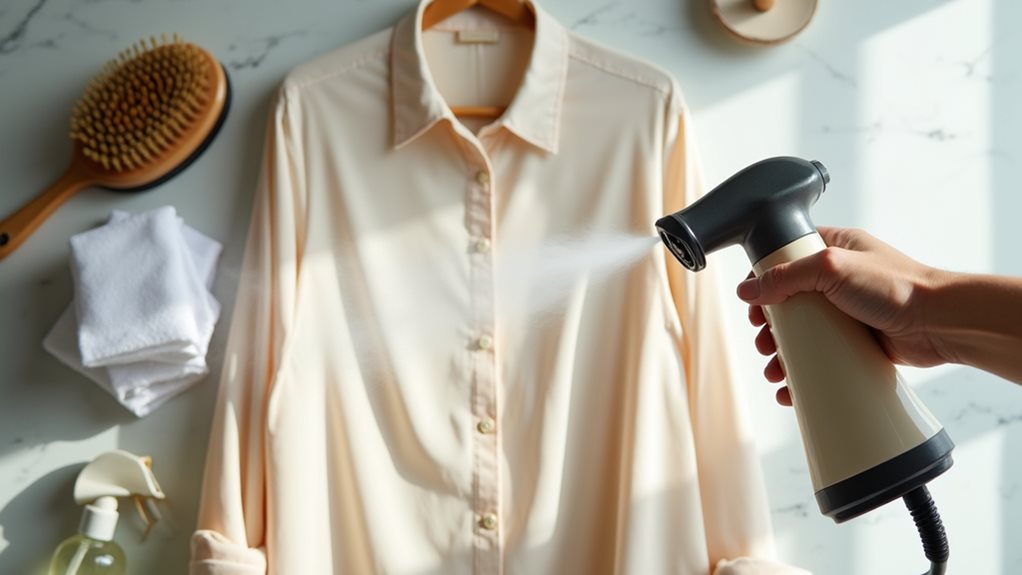
Between professional cleaning sessions, I’ve discovered several gentle methods that breathe new life into my dry-clean-only garments without risking the heartbreak of ruining another treasured piece.
These garment revitalizing techniques have saved me countless trips to the cleaner:
- Steam treatment – Hang clothes in your bathroom during hot showers, or use a handheld steamer for wrinkle and odor removal.
- Home dry cleaning kits like Dryel offer convenient solutions for light stain removal and rejuvenating delicate fabrics.
- Spot cleaning with equal parts white vinegar and water tackles small stains effectively.
- Hand washing silk or wool in cool water with mild detergent works surprisingly well when you’re gentle.
- Baking soda absorbs stubborn odors overnight, while airing clothes outside naturally revives garments between professional cleanings.
These methods have honestly revolutionized how I maintain my wardrobe! 🌟

